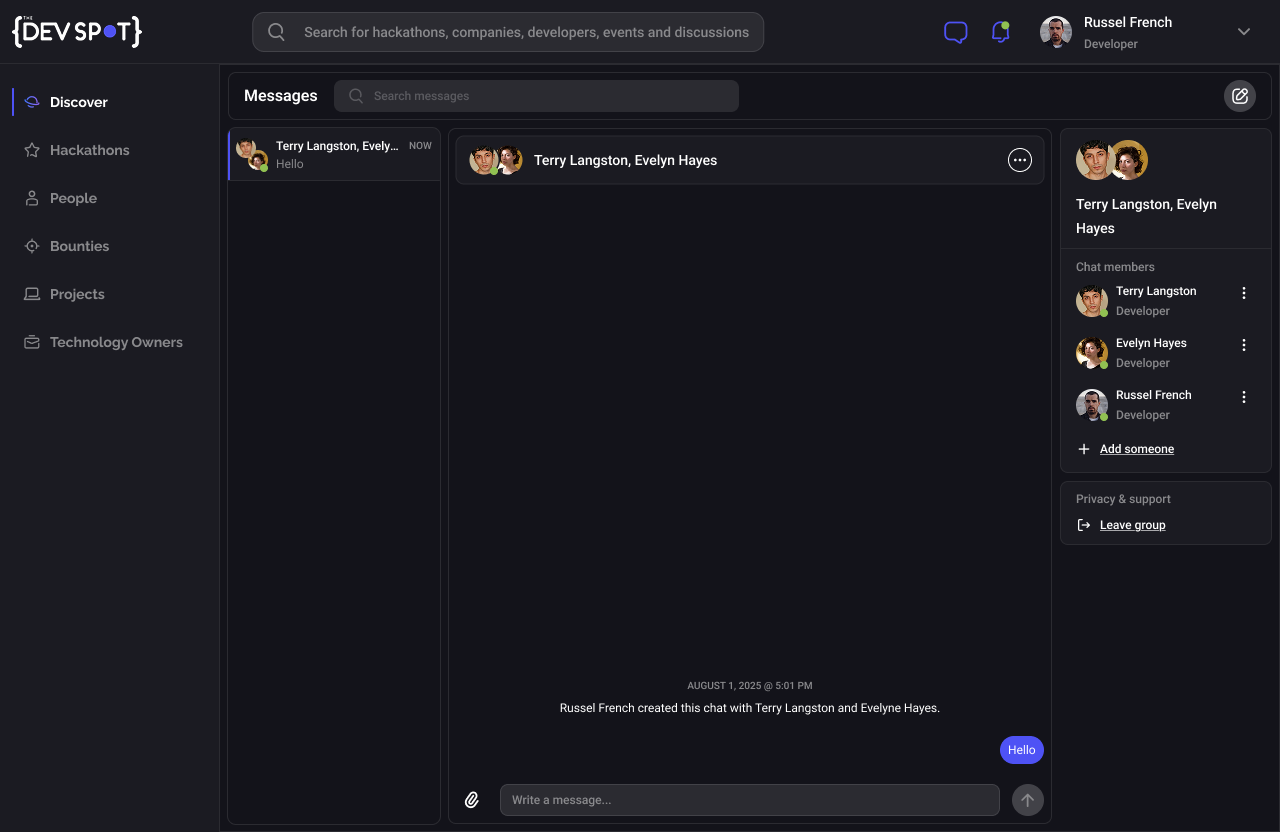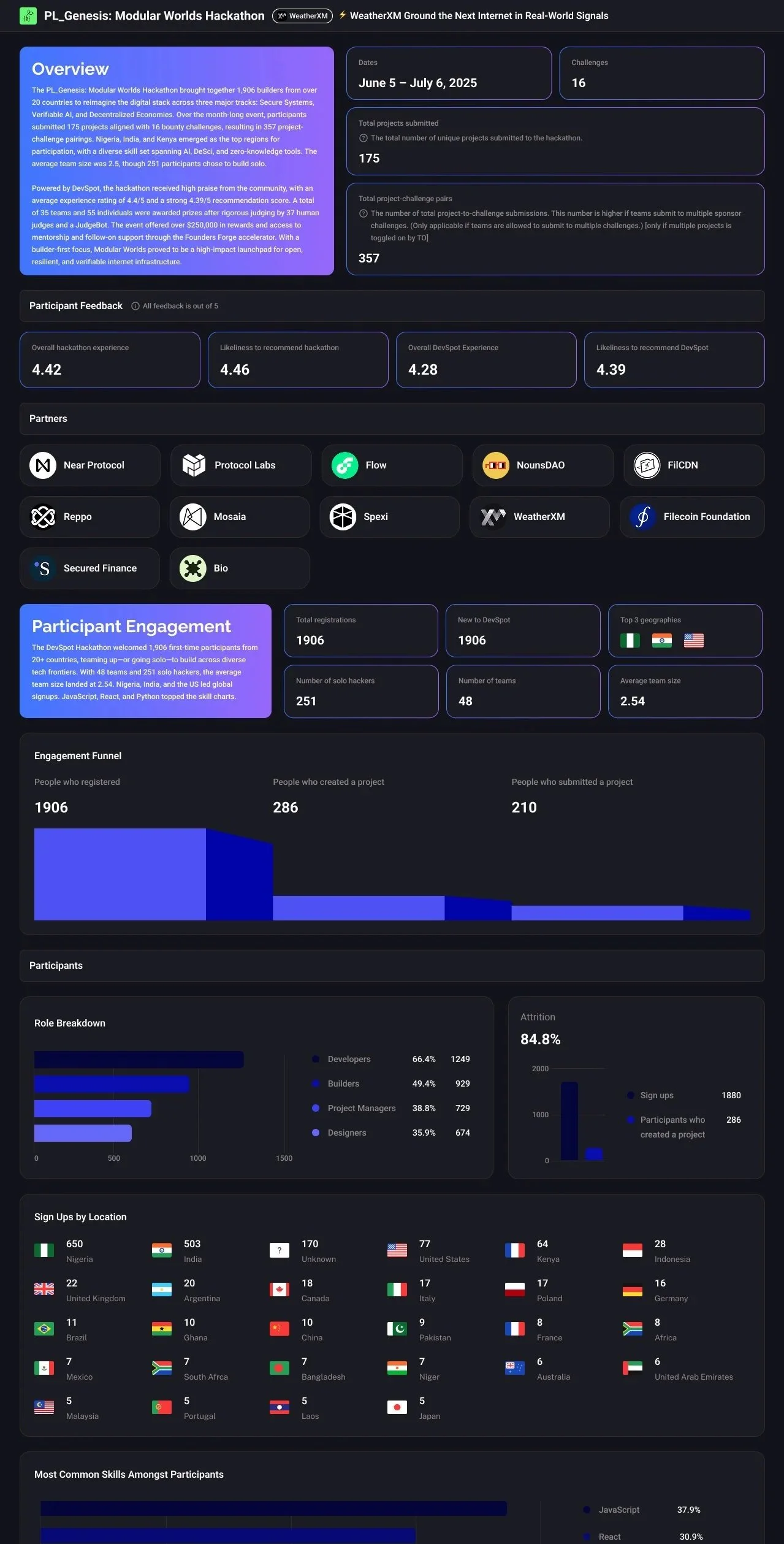Powering 2 AI Hackathon Pilots with Features Used by 200+ Participants and 10+ Sponsors
My Role
AI Product Design Intern
Team
1 Designer, 1 Founding Designer, DevSpot’s Founding Developers
Timeline
June 2025 – September 2025 (12 weeks)
Tools
Figma, Adobe Illustrator, Miro
Context
DevSpot is an AI-driven platform that connects developers, designers, and engineers through hackathons and collaborative projects. As the product scaled, the team faced challenges maintaining consistency, clarity, and engagement across both user-facing and internal tools.
During my internship, I focused on strengthening DevSpot’s foundation by:
Designing a messaging feature to streamline in-platform collaboration
Organizing, labeling, and annotating the design system for developer handoff
Designing recap reports for sponsors and partner companies after hackathon
These projects deepened my experience in AI product design, design systems management, and cross-functional collaboration with both design and engineering teams.
Problem
DevSpot’s rapid growth created three main challenges that limited user engagement and internal efficiency:
1. No Integrated Messaging Feature
Users relied on external apps to communicate, causing context-switching and fragmented workflows.
2. Disorganized Design System:
The Figma library was inconsistent, with unlabeled components and no developer documentation, which leads to slower handoffs and product updates.
3. Limited Sponsor Communication Tools
After hackathons, the team needed visually compelling reports to showcase impact and strengthen relationships with sponsors.
Research & Key Insights
To ensure my designs solved real problems, I conducted:
Developer interviews
Conducted 5 developer interviews exploring system design, scalability, and collaboration
Messaging Feature
Goal: Enable seamless team communication within the DevSpot platform.
Mapped user journeys for one-on-one, group, and AI-assisted chats
Designed wireframes and prototypes in Figma, focusing on clarity and speed
Explored AI enhancements, such as message summarization and smart tagging
Conducted usability testing with internal users to refine message flow and visual hierarchy
The messaging feature laid the groundwork for DevSpot’s future collaborative ecosystem. While still in development, the designs were praised for their clarity, scalability, and user-centered approach.
Comparative analysis
Comparative study of Jira, Notion, Slack, GitHub, and DevSpot workflows and features
Sponsor Feedback Review
Gathered insights straight from sponsors to shape better developer experiences
-
Consistent component labeling and design notes reduce confusion, helping engineers implement designs faster and minimize back-and-forth communication.
-
Focusing on essential functions and intuitive layouts ensures smoother communication and usability over adding unnecessary, complex features.
-
Data visualization, community outcomes, and personalized sponsor highlights build stronger post-event relationships and demonstrate brand value.
I used these findings to derive my How Might We statement:
“How might we create more cohesive communication, organization, and visual alignment within DevSpot to strengthen collaboration and community impact?”
Process
2. Design System Organization
Goal: Create a structured, annotated, and developer-friendly design system that aligns with AI product scalability.
Audited and cleaned DevSpot’s existing Figma library
Established a consistent naming structure and labeling system for all components
Annotated key elements with usage notes, accessibility considerations, and responsive behaviors
Improved handoff efficiency by 35%, reduced design duplication, and created a scalable system ready for AI feature expansions.
3. Hackathon Recap Reports
Goal: Design visually compelling, data-driven recap reports for sponsors and partners.
Designed dynamic templates using DevSpot’s brand palette and event analytics
Integrated impact metrics, visuals, and participant highlights for clearer storytelling
Created Figma templates for future hackathons to ensure consistency and faster delivery
Enhanced sponsor engagement and improved the clarity of event communications—reducing report turnaround time by 20%.
Key Insights
Process
Impact
My work contributed to measurable improvements across the platform and team workflow:
35% faster developer handoff
through organized design system
Integrated messaging feature prototype designed for scalability
Reflection
Working as an AI Product Design Intern at DevSpot gave me firsthand experience bridging design, AI, and engineering.
Key takeaways for me included:
Design systems = collaboration systems
A clean, documented system is essential for scaling AI products.
AI in UX is about augmentation, not automation
Integrating AI tools like message summarization can elevate usability without overwhelming users
Clear communication drives innovation
Working closely with developers taught me how documentation and empathy fuel better design outcomes
20% faster sponsor reporting
with reusable visual templates













